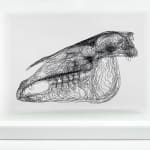Angela Palmer British, b. 1957
49 1/4 x 31 7/8 x 17 7/8 in
Eclipse was unbeaten in the 18 races he ran between 1769 and 1771. He sired many hundreds of foals and his bloodlines can be traced down through racing history with his descendants including Desert Orchid and Kauto Star. Remarkably, experts believe up to 95 per cent of today's thoroughbred racehorses can trace their lineage back to Eclipse.
When Eclipse died in 1789 aged 25 scientists performed the first known autopsy on a horse in the UK to try to discover why he was so fast. Today his skeleton is preserved and studied at the Royal Veterinary College in Hertfordshire where it continues to cause controversy. A recent study involving DNA taken from his skeleton revealed that Eclipse's parentage had been misattributed for the past 200 years and scientists are now calling for the rewriting of the horse racing bible, The General Stud Book of England.
Angela Palmer (b.1957) started her career as a journalist, first working as a columnist for the Daily Telegraph in 1982 and later becoming News Editor at The Observer (1986-1988). Palmer progressed to become Editor of The Observer Magazine (1989-1992) before moving to Elle Magazine as Editor-in-Chief (1992-1993). In 2002, Palmer studied Fine Art at the Ruskin School of Drawing and Fine Art, University of Oxford where she received the Fitzgerald Prize for her work, before continuing her studies with a Masters degree at the Royal College of Art.
Palmer's work tackles complex contemporary issues and her interest in mapping drives her to communicate these issues in powerful yet beautifully crafted works. For example in 2009, Palmer attracted major coverage for her work 'Ghost Forest', installed at Trafalgar Square in London. For her installation, Palmer sourced 10 stumps of commercially logged virgin forest from Ghana – an arresting visual statement on the impact of deforestation.
In 2015, Palmer was allowed unprecedented access to create a body of work responding to Formula 1, culminating in her exhibition 'Adrenalin' at The Fine Art Society. In collaboration with Renault Sport F1, Palmer deconstructed the RS27 engine to interrogate the intricacies of what exactly made the RS27 the most successful engine in the sport.
Palmer's work can be found in numerous public and private collections, including the Smithsonian Air and Space Museum, The National Portrait Gallery of Scotland, The National Botanic Garden of Wales, and The Science Museum, London, which holds her work The Sphere that Changed the World (Coronavirus) and is currently on tour as part of their exhibition 'Injecting Hope: The Race for a Covid-19 Vaccine'.



